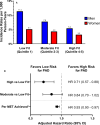Midlife Cardiorespiratory Fitness and the Development of Peripheral Artery Disease in Later Life
- PMID: 34854310
- PMCID: PMC9075370
- DOI: 10.1161/JAHA.121.020841
Midlife Cardiorespiratory Fitness and the Development of Peripheral Artery Disease in Later Life
Abstract
Background Data are sparse on the prospective associations between physical activity and incidence of lower extremity peripheral artery disease (PAD). Methods and Results Linking participant data from the CCLS (Cooper Center Longitudinal Study) to Medicare claims files, we studied 19 023 participants with objectively measured midlife cardiorespiratory fitness through maximal effort on the Balke protocol who survived to receive Medicare coverage between 1999 and 2009. The study aimed to determine the association between midlife cardiorespiratory fitness and incident PAD with proportional hazards intensity models, adjusted for age, sex, body mass index, and other covariates, to PAD failure time data. During 121 288 person-years of Medicare follow-up, we observed 805 PAD-related hospitalizations/procedures among 19 023 participants (21% women, median age 50 years). Lower midlife fitness was associated with a higher rate of incident PAD in patients aged 65 years and older (low fit [quintile 1]: 11.4, moderate fit [quintile 2 to 3]: 7.8, and high fit [quintile 4 to 5]: 5.7 per 1000 person years). After multivariable adjustment for common predictors of incident PAD such as age, body mass index, hypertension, and diabetes, these findings persisted. Lower risk for PAD per greater metabolic equivalent task of fitness was observed (hazard ratio [HR], 0.93 [95% CI, 0.90-0.97]; P<0.001). Among a subset of patients with an additional fitness assessment, each 1 metabolic equivalent task increase from baseline fitness was associated with decreased risk of incident PAD (HR, 0.90 [95% CI, 0.82-0.99]; P=0.03). Conclusions Cardiorespiratory fitness in healthy, middle-aged adults is associated with lower risk of incident PAD in later life, independent of other predictors of incident PAD.
Keywords: cardiorespiratory fitness; midlife; peripheral artery disease.
Figures


Similar articles
-
Association Between Midlife Cardiorespiratory Fitness and Risk of Stroke: The Cooper Center Longitudinal Study.Stroke. 2016 Jul;47(7):1720-6. doi: 10.1161/STROKEAHA.115.011532. Epub 2016 Jun 9. Stroke. 2016. PMID: 27283202
-
Midlife Cardiorespiratory Fitness, Incident Cancer, and Survival After Cancer in Men: The Cooper Center Longitudinal Study.JAMA Oncol. 2015 May;1(2):231-7. doi: 10.1001/jamaoncol.2015.0226. JAMA Oncol. 2015. PMID: 26181028 Free PMC article.
-
Independent and joint associations of cardiorespiratory fitness and BMI with dementia risk: the Cooper Center Longitudinal Study.BMJ Open. 2023 Dec 12;13(12):e075571. doi: 10.1136/bmjopen-2023-075571. BMJ Open. 2023. PMID: 38086580 Free PMC article.
-
The association between midlife cardiorespiratory fitness and later life chronic kidney disease: The Cooper Center Longitudinal Study.Prev Med. 2016 Aug;89:178-183. doi: 10.1016/j.ypmed.2016.05.030. Epub 2016 May 31. Prev Med. 2016. PMID: 27261408
-
Association of Midlife Cardiorespiratory Fitness With Incident Depression and Cardiovascular Death After Depression in Later Life.JAMA Psychiatry. 2018 Sep 1;75(9):911-917. doi: 10.1001/jamapsychiatry.2018.1467. JAMA Psychiatry. 2018. PMID: 29955781 Free PMC article.
References
-
- Fowkes FGR, Rudan D, Rudan I, Aboyans V, Denenberg JO, McDermott MM, Norman PE, Sampson UKA, Williams LJ, Mensah GA, et al. Comparison of global estimates of prevalence and risk factors for peripheral artery disease in 2000 and 2010: a systematic review and analysis. Lancet. 2013;382:1329–1340. doi: 10.1016/S0140-6736(13)61249-0 - DOI - PubMed
MeSH terms
LinkOut - more resources
Full Text Sources
Medical

